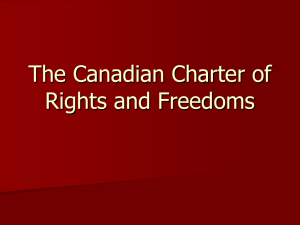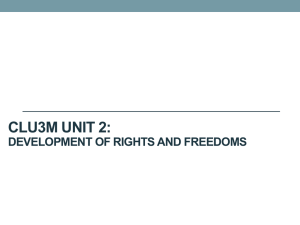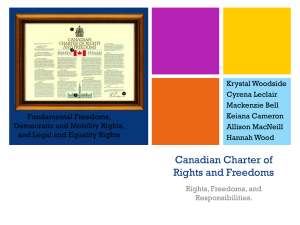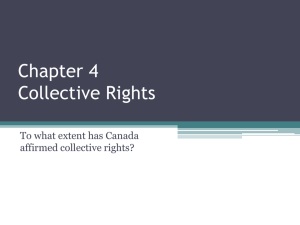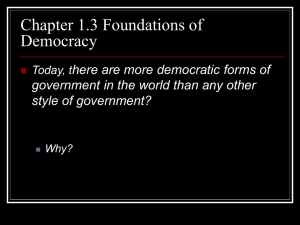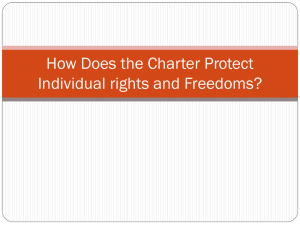Social Review
advertisement
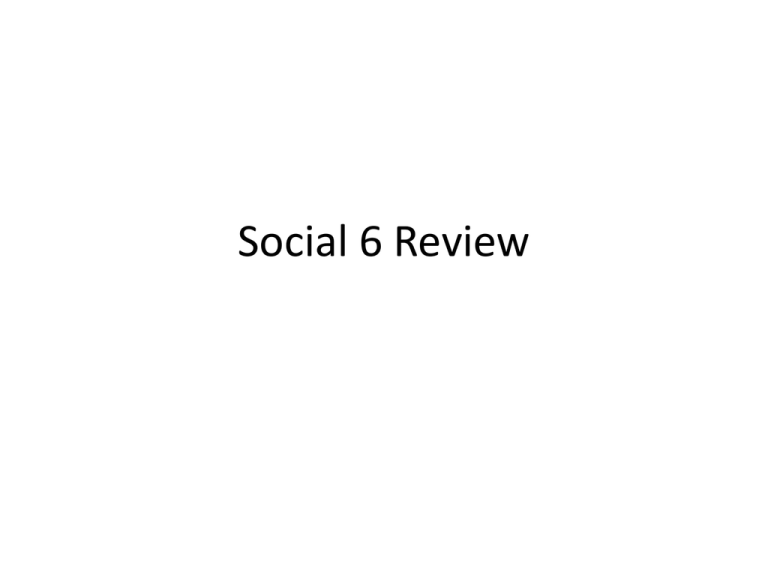
Social 6 Review What is Democracy? • Power resides in the people • Four pillars of democracy: Justice, Equity, Freedoms, Representations • Democratic values = Values of the people • Democratic values = equality, right to vote, fairness, compromise, peacefulness • In Canada decisions are made by the people, by the majority, and often by representation What is democracy? There are 3 types of government: • Local (municipal) • Provincial/ Territorial • Federal *Each level has elected and appointed citizens who represent the majority What is Democracy? What are the similarities and differences between direct and representative democracy? • In Canada all citizens can participate directly in government matters, but it is hard to do so all of the time for every person. – Travel – Time – Listening to all opinions This is why we use representative democracy Representative Democracy • In a representative government, the candidate who gets the most votes will represent the majority • This happens in all 3 levels of government: local (municipal), provincial/ territorial, federal Direct Democracy • Canadian representative democracy is related, but different from the direct democracy practiced in Ancient Athens • Athenian citizens = males who were not Metics of Slaves • These citizens were responsible for being active participants in the government Direct Democracy • Athens – most important body of government was the Assembly which took place at the Pnyx • Had to be a male citizen over 20 years old • Thousand of men often attended, all had right to speak • Voting taken by counting hands, or sometimes placing coloured stone in a jar Direct Democracy • Males citizens over 30 were also expected to serve on the Council of 500 or in the courts as a part of the jury. Direct Democracy Bad things about the Athenian Direct Democracy model: – Not all people could vote – Not all people were considered equal Direct Democracy in Canada • Sometime in Canada we have referendums or plebiscites. • Example 1982: Division of Northwest Territories are put to a plebiscite. Decision by the direct vote was in favour of division. Thus Nunavut was created in 1993 What if…? What if your class was offered $100 and you had to decide what to do with it… What would the decision-making process be like if your class were a direct democracy? What would it look like if your class was a representative democracy? What would it look like if your class made decision by consensus? What would it look like if you class was a dictatorship? What are the similarities and differences between direct and representative democracy? What are the rights and responsibilities of citizens living in a representative democracy? • Canadian rights promised by the Canadian Charter of Rights and Freedoms. • 34 sections entrenched into the Canadian Constitution • Rights = Responsibilities • Right to vote = Responsibility to be an informed voter What are the rights and responsibilities of citizens living in a representative democracy? • It is our responsibility as citizens to tell our government about our needs and concerns, so that the government knows what we need • It is our responsibility to help better our communities for common good What are the rights and responsibilities of citizens living in a representative democracy? How does Canada’s justice system help protect your democratic and constitutional rights? • Games need rules/ societies need laws • Constitution is Canada’s supreme document which includes laws and rights (laws uphold rights) • Laws reflect Canadian values (fairness, respect, equality, peacefulness) • The job of the Justice system is to protect the Rights of Canadians by enforcing the law Supreme Court of Canada • Supreme Court of Canada can review laws if it conflicts with Rights and Freedoms • Protecting these rights and common good is essential to Canadian Democracy How does Canada’s justice system help protect your democratic and constitutional rights? How does the Canadian Charter of Rights and Freedoms protect the individual rights and freedoms of all Canadians? • Rights and Freedoms are guaranteed by law since they are entrenched in the Constitution • Laws can be challenged by individuals or groups if they do not feel their rights are being upheld (Justine Blainey) Sections in the Charter of Rights and Freedoms • • • • • • • Fundamental Freedoms Democratic Freedoms Mobility Rights Legal Rights Equality Rights Official Language Rights Other Rights (aboriginal rights, Sections of the Charter • Fundamental Freedom- freedom of speech, thought, opinion and religion (in a peaceful manner) • Democratic Rights – Right to vote for representatives in the government. Democratic rights have expanded over the last century (100 years), allowing women and all cultures to vote • Mobility Rights – citizens can move, work, and travel anywhere in Canada • Legal Rights – Protect citizens involved in legal conflict. (Ex: Innocent until proven guilty) • Equality Rights – Ensure equal and fair treatment for everyone. Sometimes this includes accommodations (Ex: building a school elevator for someone in a wheel chair so they may have access to school as other students have. • Official Language Rights – bilingual country (French and Canadian) Government signs, services in both languages. • Other Rights – Aboriginal Rights • Gender Equality Rights added in 1982 (section 28). Equal pay and treatment for women in the work place. How does the Canadian Charter of Rights and Freedoms protect the individual rights and freedoms of all Canadians? • What types of freedoms and rights are in the Charter? How does the Canadian Charter of Rights and Freedoms protect collective rights? • Collective rights protect particular groups, these groups have a collective identity (shared beliefs, values, language, culture) • These groups have a long history that precedes (came before) the Confederation of Canada in 1867. • The main Collective Rights that are protected include rights of aboriginal groups and official language minorities Collective Rights in Canada • Examples of Official Language minorities are Francophones (French speakers) in Lethbridge, or Anglophones (English speakers) in Quebec City • When the Charter was entrenched in 1982, so were the above collective rights Collective Rights for Aboriginal Peoples after 1982 • First Nations, Metis, Inuit (FNMI) – Regaining Land Titles/ Claims – Regaining Rights – Self- Governance – Control over Natural Resources on their land – Compensation (money) for impacted lands – Consultation over land development Self- Governance • 1999, Section 77 (1) of the Indian Act, was changed. • Prior only First Nations living on reserves could vote for band leaders. • John Corbiere, chief of Ontario’s Batchwan Nation agrued that First Nations people on reserves and off reserves needed to have a vote in order for their to be equity and fairness Protecting Collective Rights for Official Language Minorities • Both Francophones and Anglophones were important in establishing Canada as a Confederation, therefore their language rights are important • Government buildings and services must be offered in both languages How does the Canadian Charter of Rights and Freedoms protect collective rights? How did the Treaty of La Grande Paix de Montréal address Collective Identity and Collective Rights? • Before European settlement, there were many aboriginal communities. Europeans were the first non-aboriginals to settle in Canada • French wanted to improve the fur-trade between them and the Ouendat and Algonquin. But these First Nations groups were in conflict with the Haudenosaunee • This conflict was preventing the settlement of Montreal, which was important to the French and the fur-trade Treaty of La Grande Paix de Montreal (1701) • The Governor of New France wanted Peace between all First Nations groups (not just between the Haudenosaunee) • Dozens of First Nations groups met in Montreal to discuss peace and treaty • Approximately 1,300 people from 40 Aboriginal groups come to discuss • These discussions led to the signing of the Treaty of La Grande Paix de Montreal Treaty of La Grande Paix de Montreal (1701) • Each group’s identity and opinion was respected, thus respecting collective identity • The groups worked together through cooperation and compromise for common good How did the Treaty of La Grande Paix de Montréal address Collective Identity and Collective Rights? How do the Treaty of GPM (1701) and the Canadian Charter (1982) compare in addressing individual and collective rights? • These documents were written over 300 years apart, but are very similar in how they address individual and collective rights How do the Treaty of GPM (1701) and the Canadian Charter (1982) compare in addressing individual and collective rights? Individual Identity GPM – respected the identity of each FN group CC – guarantees individual rights and freedoms How do the Treaty of GPM (1701) and the Canadian Charter (1982) compare in addressing individual and collective rights? Collective Identity GPM – respected the identity of each FN group. Treated the French and the FN groups as equal and independent nations CC – respects FN collective identity and official language minorities How do the Treaty of GPM (1701) and the Canadian Charter (1982) compare in addressing individual and collective rights? Collective Rights GPM – Ensured collective rights for French and FN groups. FN groups could be self-governing and hunt on territorial lands CC – guarantees collective rights of FNMI groups and the official language minorities Treaty of La Grande Paix de Montreal (1701) • Can be thought of as an early model of human rights in Canada • Build with fairness, equality, respect, representation, and fundamental freedoms in mind. All of these things are the foundation of our democracy and our Charter How do the Treaty of GPM (1701) and the Canadian Charter (1982) compare in addressing individual and collective rights? Why is the Canadian Charter entrenched in the Constitution? • To guarantee rights and freedoms by law • Entrenchment happened on April 17, 1982 (Constitution Act) • These rights are now protected, because changing the Constitution in very hard to do, helping to ensure our democratic society • Before the Charter in 1982, there was the Canadian Bill of Rights (1960). CBR was limited because it was 1) a bill and 2) only could be used in federal law, not provinicial Why is the Canadian Charter entrenched in the Constitution? How are representatives chosen to form a local government? • Towns, cities, villages, municipal districts = municipalities • Each municipality has its own form of local government • Local elections happen about every 3 years • Electoral Process- Constituents vote for the candidate they feel best represents their views Becoming a local government candidate • Nomination • Pay candidate fee/ fill out forms/ background check • Campaign: speeches, signs, debates, door to door • Secret ballot vote • Candidate with majority vote wins Elected Local Leaders • Mayor – Urban Areas • Reeve – Rural Areas • Chief – First Nations/ Metis • Council members are local government members who are elected • Council members help the leader make decisions on issues, programs, bylaws, etc. How can you (a non-voter) make a difference? 1) 2) 3) 4) Identify the issue of concern Research Contact local council, MLA Council then will discuss and review your information How are representatives chosen to form a local government? What are the responsibilities of local government? • Listening to citizen’s concerns • Enforcing and passing bylaws in order to meet community needs • Providing services to the community • Collecting taxes (property) What are the responsibilities of the citizens? • • • • Vote Attend council meetings Express views on issues May run for election Bylaws • Bylaws are created by local government for the safety and respect of their citizens • An example of a bylaw is ‘no smoking in any public place’ or ‘no letting dog’s off-leash in parks’. • The law is only upheld in the municipality it is created in. (Ex: Calgary bylaws are not laws in Lethbridge, only in Calgary) Services provided by local government • • • • • • • • Libraries Parks Senior citizens facilities Road and bridge construction Police services Garbage collection Storm and drain sewers Various other local services Taxes • In order for the local government to gain revenue (money/ income) they collect taxes • These taxes are mostly in the form of property taxes • Also gained by user fees (Ex: bus ticket), community rentals (ex: picnic spots at Henderson) What are the responsibilities of local government? • • • • Responsibilities? Bylaws? Services? Taxes? How are local governments structured differently in rural and urban settings? Urban vs. Rural • Urban: larger populations (cities, town and villages) • Rural: lower populations (parkland, forested areas, farmland, Metis settlements, First Nation Reserves) First Nations form of government • According to the British America Act of 1867, the federal government runs the First Nation reserves • FN communities have their own government, called a band council • Chief is elected, council is appointed • More population, the larger the council • Bylaws = Band Council Resolutions Metis Form of Government • • • • • • Self-governance 8 Metis settlements Elected Local Council of 5 Chairperson is appointed by the Council Govern their local areas and make bylaws Together all 40 councillors make up the Metis settlement General Council How are local governments structured differently in rural and urban settings? • What is the difference between rural and urban • What is an urban local gov. leader called? • What is a rural local gov. leader called? • What is the FN local gov. called? What is their leaders title? • How many councillors are in the Metis local gov.? What is their leaders title? What are the similarities and differences between rural and urban local government? • These structures are different mainly because of the different numbers of people they must serve (less people in the rural areas) They are similar in the following ways: 1) An elected council 2) Committees and a chief administrator 3) Departments What are the similarities and differences between rural and urban local government? • Similarities? • Differences? What role is played by school boards? • Province of Alberta takes care of Alberta’s Education • School boards make sure that all educational needs are being met in their local area (Ex: Lethbridge) • More than 50 school boards in Alberta (public, separate, private and Francophone) • School board = a hired superintendent, elected trustees. They make decisions on budget, policy and programming Parents’ right to choose the type of school their children attend • • • • • Separate Schools Public Schools Francophone Schools FNMI Schools/ Educational Programming Charter Schools Parents’ right to choose the type of school their children attend • Separate Schools – mainly Catholic schools • Public Schools – open to all students • Francophone Schools – CC maintains the collective rights of the French-speaking Albertans have the right to education in French • FNMI Schools/ Educational Programming – Aboriginal identity, culture and language are taught • Charter Schools – these schools have a special focus or are for a particular group. For example, all Girls school, athletics focus, fine arts focus, etc What role is played by school boards? • • • • • Responsibilities of the school board? How makes up a school board? Parents’ rights? Different types of school board in Alberta (5)? What are the main differences between each school board? How is the provincial government structured? • 1 MLA per constituency • MLAs represent their constituents concerns and help make laws • The political party with the most members of the Legislative Assembly governs the province. Their leader become the Premier • Premier selects cabinet ministers • Cabinet ministers run departments (ex: education) • Premier + cabinet = executive council How is the provincial government structured? • How is the Premier chosen? • Are MLAs appointed or elected? • What do we call the party with the most MLA seats? • What do we call the party with the second most MLA seats? What is the role of the LieutenantGovernor? • Appointed by the Governor General and Prime Minister • Acts on behalf of the Queen, signs bills to make them laws • On paper is the head of provincial government, but does not have any real power • Does not belong or favour any political party Lieutenant Governor has many jobs, but the most important are: • Signing of bills (granting royal ascent) • Swearing in MLAs • Chief Executive Officer of the Province (makes sure all candidates and politicians obey the law) Hierarchy of the Provincial Government • Lieutenant Governor • Premier • Cabinet Ministers • MLAs (Legislative Assembly) What is the role of the LieutenantGovernor? • Elected or appointed? By whom? • What are the 3 main responsibilities of the LG? • What is the hierarchy of the Provincial Government? What are the responsibilities of the Provincial Government? • • • • • Serve the people of the province Create jobs for a stronger economy Improve health care Spending wisely, while still providing services Develop resources, while still caring for the environment • Create safe and vibrant communities Passing Provincial Laws • Bill introduced by an MLA • First Reading at the Legislative Assembly • Bill is studied and public input is heard through public meetings, petitions, letters • Second reading in the Legislative Assembly • Debate by MLAs, vote, revised • Third reading, debate, vote • If the majority vote for the bill, it becomes law after the Lieutenant Governor signs Services Provided by the Provincial Government • • • • • • • Education Environment Highways Transport Seniors and Community Support Tourism, Parks, Recreation Health and Wellness Employment and Immigration Provincial Government Taxes To gain revenue (income/money). These revenues are gained by collecting: • Income Tax • Program fees such as healthcare premiums What are the responsibilities of the Provincial Government? • What are their main roles? • How are bills passed in provincial government? • What services do they provide? • How do they gain revenue? How are representatives chosen at the provincial level of government? • Provincial elections held every 4 years or so, the charter states it must be done every 5 years • Premier and MLAs = elected • Lieutenant Governor and Cabinet members= appointed To run in a provincial election, one must… • Be an eligible voter in their province • Have a form signed by 25 voters in their constituency • Campaign • Chief Electoral Officer (aka?) ensure all is run according to law • Vote by secret ballot. MLAs in each constituency that gets majority votes wins the seat • 87 constituencies in Alberta= 87 MLAs How are representatives chosen at the provincial level of government? • Who is elected in the Prov. Gov? Who is appointed? Who is from the same political party? • How often do prov. elections occur? What is the difference between a MLA and a Cabinet Minister MLAs have 2 main responsibilities: 1) Representing their constituents (maintaining open office, community functions, informing constituents about what is happening) 2) Participate in Government (introducing and passing bills, committees, interests groups) Cabinet Ministers • Cabinet Ministers are MLAs appointed by (chosen) by the Premier. They are assigned a specific department of Responsibility (such as Education, Energy). They are to: 1) Make decisions 2) Develop government policies 3) Review government spending What is the difference between a MLA and a Cabinet Minister • Name the 2 main jobs of a MLA • Name the 3 main jobs of a Cabinet Minister How can individuals, groups, and associations within a community participate in the decision-making process regarding current events or issues? • Lobbying (interest group who work with government) • Petitioning • Organizing and attending local meetings • Rallies • Contacting elected candidates • Grassroots Organizations (study issues and watch the government) • Non-Governmental Organizations (NGO-larger, can be international, donations, volunteers) • How can individuals, groups, and associations within a community participate in the decision-making process regarding current events or issues? How do associations provide their members a voice at local and provincial levels to exercise historical and constitutional rights? Three examples of Associations: • Association Canadienne-Francaise de l’Alberta (ACFA) • First Nations Authorities (FNA) • Metis Nation of Alberta Association (MNAA) Association Canadienne-Francaise de l’Alberta (ACFA): • Worked to preserve French language, culture and identity • Newpapers, libraries, TV broadcasting, Film Festival, Francophone school boards, First Nations Authorities (FNA) • TGPM (1701) and the Royal Proclamation 1763 respected the rights of Aboriginal peoples • When Confederation happened in 1867, Aboriginals lost the right to self-govern • Regained in 1982 (Constitution and Entrenchment of the Charter) • FNA acts on behalf of the 46 FN at the local level of government • Oversee local matters in affecting their communities • Goal is to maintain self-governance • They have other authorities (like councils) on Education, Finance, Police and Health so that they control these programs in their communities Metis Nation of Alberta Association (MNAA) • Metis have ancestry to the FN and Europeans. They were not recognized as people until The Constitution Act in 1982 They want to guarantee two main things for their people: • Land and resource rights • Self-governing rights How do associations provide their members a voice at local and provincial levels to exercise historical and constitutional rights? • What types of actions does the ACFA take? • What is the main thing that FNA wants? • What 2 main things does the MNAA wants? How do elected officials demonstrate their accountability to the electorate? • Elected are responsible to represent their constituents need and viewpoints They show that they are doing this by: • Listening and talking with their constituents • Addressing needs and concerns • Building communities • Maintaining office • Must obey the law= rule of law • Follow the principles of FREJ (Freedom, Representation, Equity and Justice) • How do elected officials demonstrate their accountability to the electorate?
